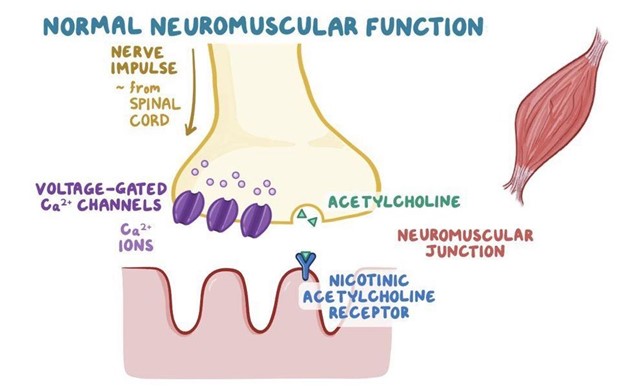Myasthenia Gravis in Dogs

What is myasthenia gravis?

Figure: Normal neuromuscular function
In most cases, myasthenia gravis (MG) is a disorder that develops due to an immune system attack (autoimmune) against the acetylcholine receptor. This prevents the energy packets (acetylcholine) from attaching to the receptor, causing muscular weakness and excessive fatigue. This may affect muscles associated with the eyes, face, throat, esophagus or legs. The disease process is known to develop in two different groups of patients; very young dogs and older dogs.
What are the signs of myasthenia gravis?
Clinical signs can be limited to only one muscle group or affect the entire body and can include:
- regurgitation
- difficulty swallowing
- voice change
- multiple cranial nerve abnormalities (which affect movement of the face and throat)
- generalized muscular weakness
How is my pet diagnosed with myasthenia gravis?
What happens if my pet is diagnosed with myasthenia gravis?
Acquired MG can be associated with a variety of other autoimmune and cancerous disorders, so it is important to try to rule out those disorders as possibilities. Some disorders associated with MG include:
- hypothyroidism
- hypoadrenocorticism
- thrombocytopenia
- hemolytic anemia
- thymoma
- osteogenic sarcoma
- cholangiocellular carcinoma
- anal sac adenocarcinoma
- cutaneous lymphoma
How is myasthenia gravis treated?
How long will my pet need treatment for?
Currently, literature states that 90% of dogs entered clinical remission around 6.4 months after diagnosis (range 1-18 months). Unfortunately, those that did not enter remission eventually developed cancer 1-3 years after diagnosis. The most important factor in obtaining a good clinical outcome is most cases is an early and accurate diagnosis.
What are risks of myasthenia gravis?
One of the biggest risks of acquired MG is the development of aspiration pneumonia secondary to megaesophagus. Patients with MG should be closely monitored for signs of pneumonia, including:
- increased respiratory rate and effort
- yellow/green/white nasal discharge
- cough
Pets with myasthenia gravis should be fed in an inclined or upright position and should stay in that position for 10-15 minutes after any feedings or medication administration to reduce the risk of regurgitation and aspiration. Even with spontaneous remission of acquired MG, not all dogs experience resolution of their megaesophagus. Therefore, pets may need to continue upright feedings for the rest of their life, even after completing treatment for MG.
Articles by Specialty
- Cardiology (19)
- Large Animal Internal Medicine (23)
- Neurology (17)
- Oncology (21)
- Small Animal Internal Medicine (29)
Articles by Animal
- Cats (35)
- Dogs (52)
- Farm Animals (5)
- Horses (12)
